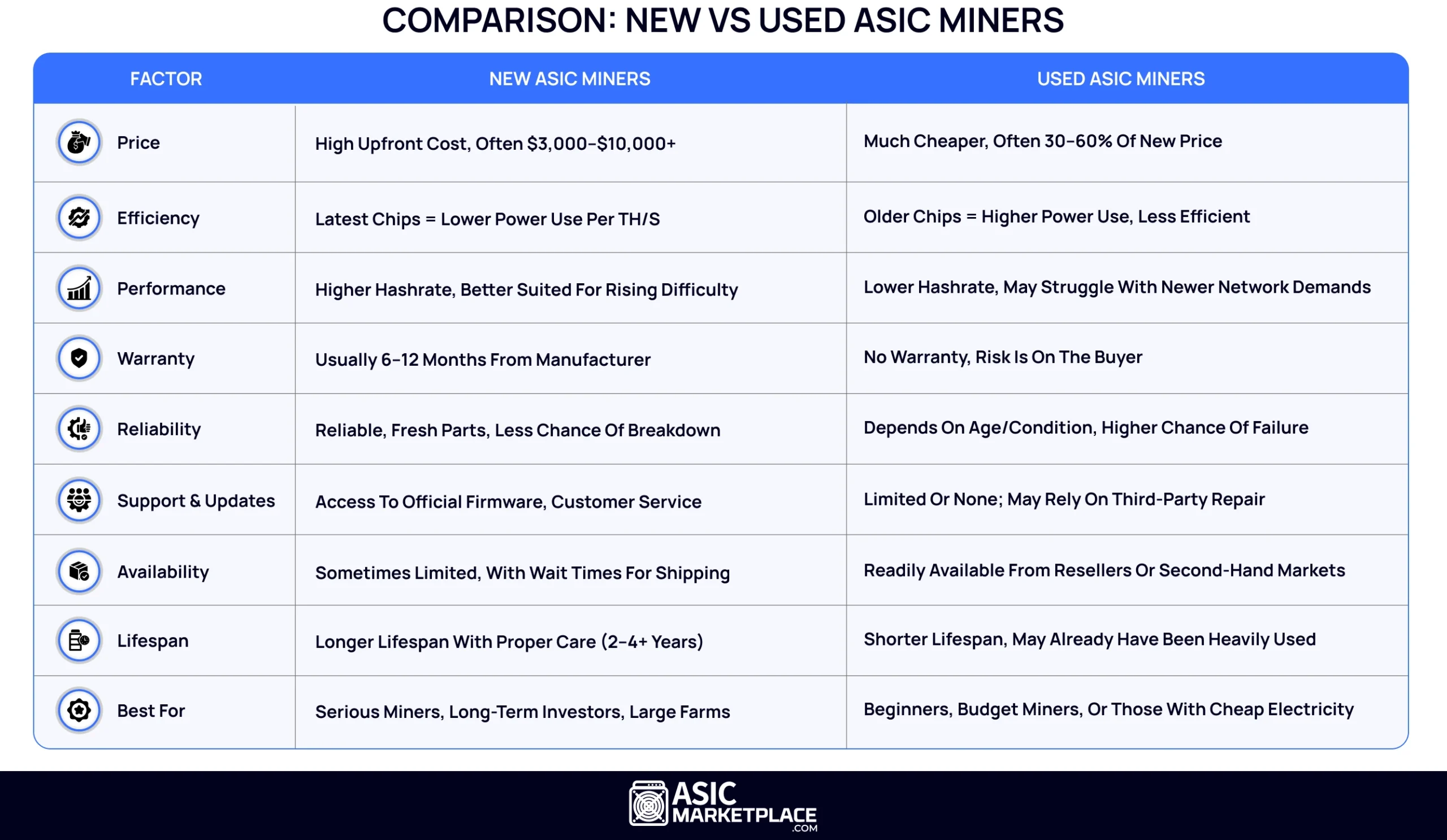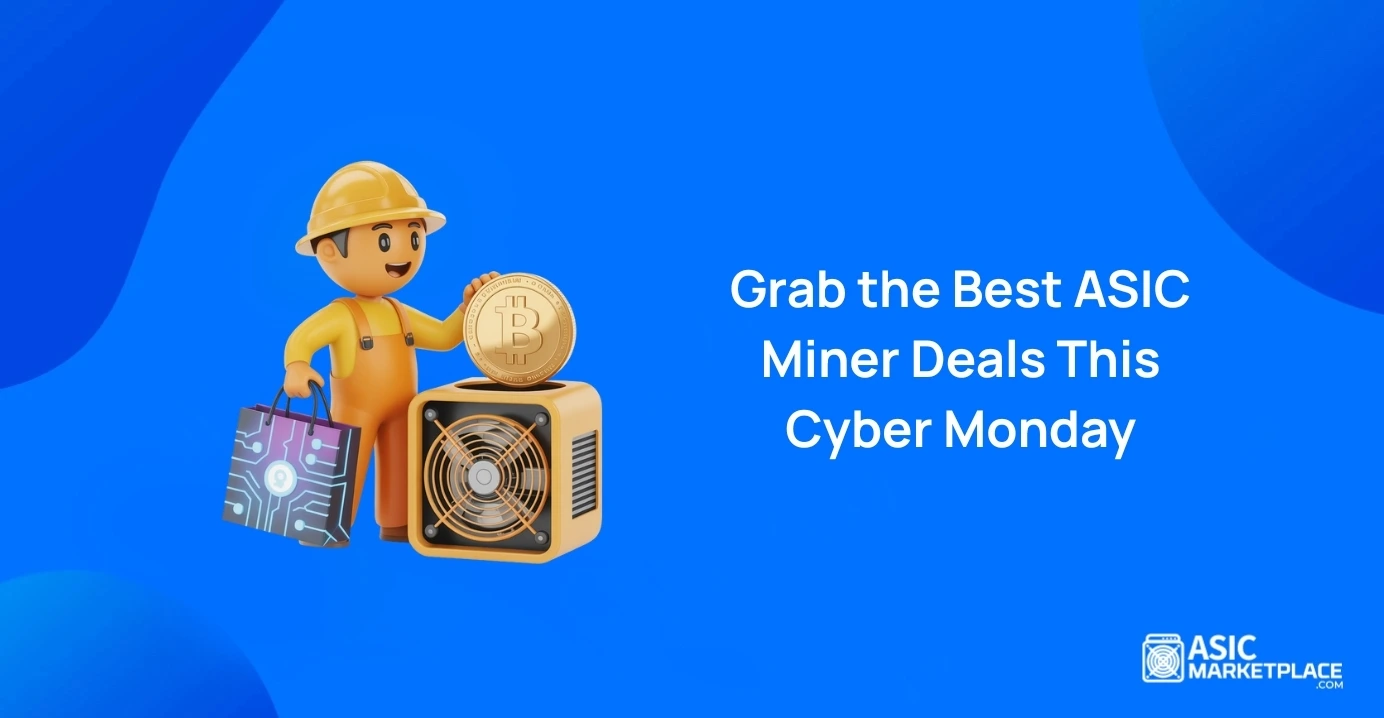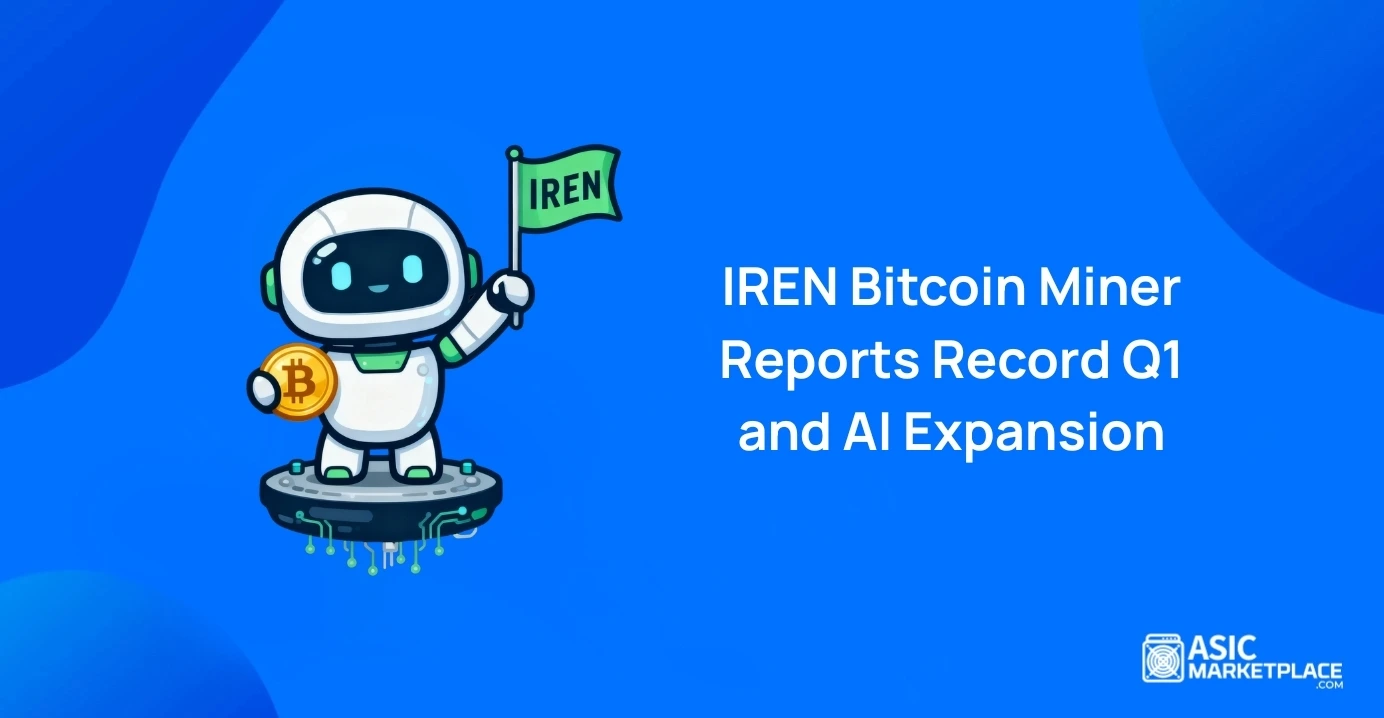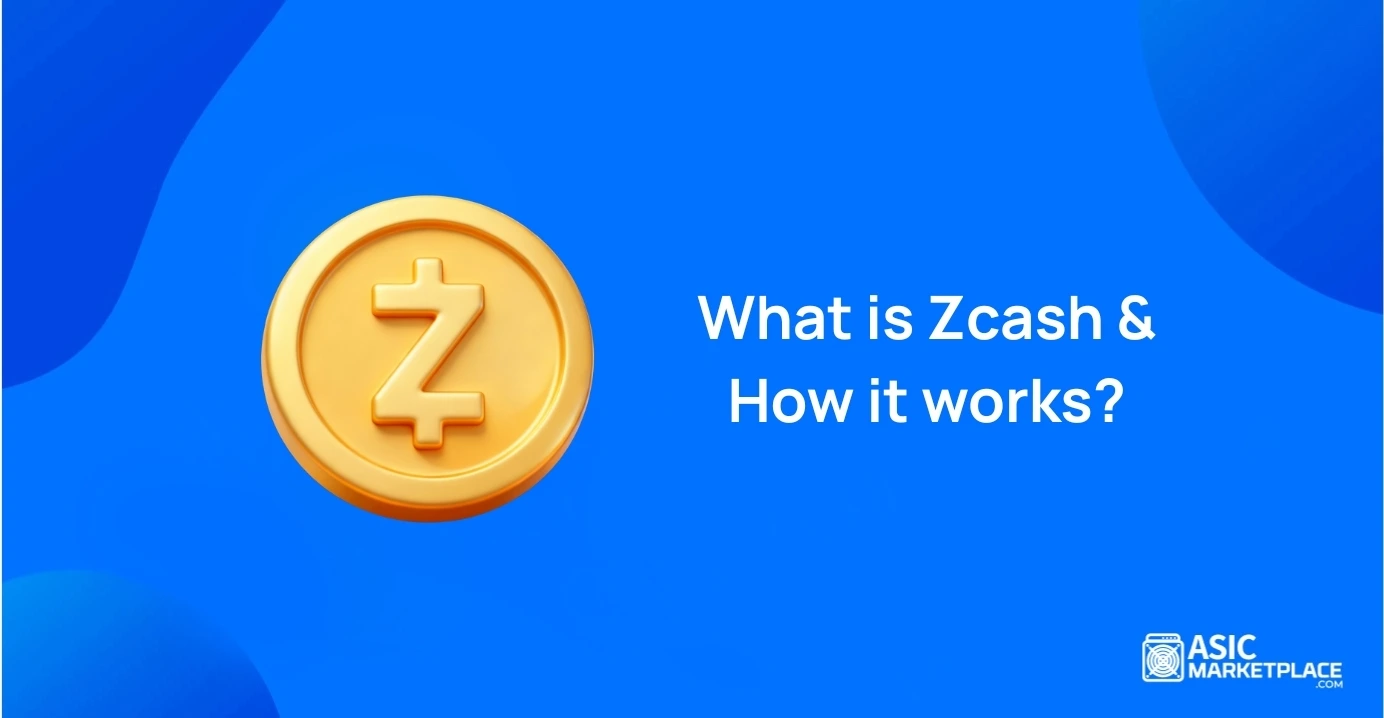Quick Summary
When it comes to Bitcoin or crypto mining, the ASIC miner you choose can decide whether you make money or lose it. Buying a miner is not just picking the machine with the highest hashrate. It’s also about how much you spend upfront, how much electricity it consumes, and how long it will last.
Many beginners ask, “Should I buy a brand-new ASIC miner or get a used one?” This is a smart question because miners are expensive, and the wrong choice can waste money and time.
New miners may look attractive with shiny performance numbers, but they are more expensive. On the other hand, used miners are cheaper, but they have risks like shorter lifespans and no warranties.
In this blog, we’ll explain ASIC miners, compare the pros and cons of new vs. used, discuss performance, costs, and risks, and give you a clear idea of which option best suits your mining journey.
What Are ASIC Miners and How Do They Work?
What Does ASIC Mean?
ASIC stands for Application-Specific Integrated Circuit. Simply put, it’s a special computer chip for only one job. Unlike a laptop or desktop computer that can run different software, an ASIC miner is designed only to mine cryptocurrency.
For example, you can think of a Swiss army knife vs. a kitchen knife:
- A Swiss army knife can do many things, but not perfectly.
- A kitchen knife is made only for cutting and does that job very well.
- ASIC miners are like the kitchen knife—built for one task, and they do it extremely efficiently.
How Do ASIC Miners Work?
Cryptocurrencies like Bitcoin run on a Proof of Work (PoW) system. In this system, miners solve very tough math puzzles to add new transactions to the blockchain, which requires a lot of computer power.
Here’s the process in simple steps:
- Transactions happen on the network.
- Miners compete to solve a puzzle first.
- The winner can add a “block” of transactions to the blockchain.
- The winning miner receives a block reward (new coins + transaction fees).
ASIC miners are the fastest at solving these puzzles, so they are the leading choice for serious miners.
Why ASICs Are Better Than GPUs or CPUs
Long ago, people mined Bitcoin using regular computers (CPUs) and later with powerful graphics cards (GPUs). However, as competition grew, these methods became too slow and costly.
ASIC miners changed the game because they are:
- Much faster: Can solve more hashes per second.
- Energy efficient: Use less electricity for the same work.
- Specialized: Only mine one algorithm, such as SHA-256 for Bitcoin.
For example:
- A GPU might produce 60 MH/s for mining.
- An ASIC like the Bitmain Antminer S21 can produce 200 TH/s—millions of times more power!
ASIC miners are powerful, specialized machines that make mining possible at scale. They are the backbone of crypto mining today. Whether you buy new or used, understanding how they work will help you compare performance, efficiency, and costs in later sections of this guide.
The Case for New ASIC Miners: Benefits and Downsides
When comparing new and used ASIC miners, buying a new one is easy. They’re straight from the factory, packed with the latest features, and usually perform better. But seeing both sides of the story is essential before you jump in. Let’s break it down.
Benefits of New ASIC Miners
1. Latest Technology
New machines come with upgraded chips that are much more powerful and efficient. For example, the Bitmain Antminer S21 can reach 200 TH/s with an efficiency of 17.5 J/TH. Compare that to an older Antminer S9, which only manages about 14 TH/s at 95 J/TH. The difference in speed and electricity use is massive, meaning new models mine more while spending less on power.
2. Lower Risk of Failure
Since everything is brand new, you don’t have to worry about worn-out fans, overheated hashboards, or weak power supplies. On average, new miners run smoothly for at least the first 1 – 2 years with very little maintenance.
3. Warranty Coverage
Most manufacturers provide a 6 – 12 month warranty for new miners. If a part fails, you can usually get a repair or replacement at no extra cost. This kind of protection is rarely available with used miners.
4. Better Firmware and Updates
Manufacturers actively release software updates for their latest models. These updates can improve hashrates, reduce bugs, and even lower energy usage over time – giving you more value from your purchase.
Downsides of New ASIC Miners
1. High Upfront Price
The biggest drawback is cost. A brand-new Antminer S21 can cost between $5,000 and $8,000, a heavy price tag for hobby miners or beginners.
2. Slow ROI (Return on Investment)
Because of the high upfront cost, it usually takes 12–24 months to recover your money, depending on Bitcoin’s price and your electricity rate. If the market dips, your ROI period could stretch even longer.
3. Availability Issues
New ASIC models are often sold in limited batches. You should pre-order and wait months before getting your unit. By the time it arrives, mining difficulty may have increased, cutting into profits.
New ASIC miners are the safer long-term choice if you can afford them. They save on electricity, come with warranty protection, and deliver better performance. But they require patience and a bigger upfront investment.
The Case for Used ASIC Miners: Benefits and Downsides
Buying a used ASIC miner feels like a budget-friendly option for many miners. The lower price makes it attractive, especially for beginners or those who don’t want to risk thousands of dollars upfront. But like buying a second-hand car, used miners come with hidden risks. Let’s explore both sides.
Benefits of Used ASIC Miners
1. Lower Upfront Cost
The biggest reason people buy used ASICs is the price. Instead of spending $5,000–$8,000 on a new Antminer S21, you could grab a used Antminer S19 or S9 for $500 – $2,000. This makes it easier to start mining without a massive investment.
2. Faster ROI (Return on Investment)
Since you spend less initially, you may recover your money faster. For example, a used Antminer S19 bought for $1,200 could pay itself off in less than a year if Bitcoin’s price is strong.
3. More Accessible for Beginners
Used miners allow new hobbyists to learn how mining works without breaking the bank. It’s a cheaper way to test mining before scaling up.
4. Plenty of Supply
When new models are released, many farms sell off their older units in bulk. This means you can often find used miners available quickly without waiting months for pre-orders.
Downsides of Used ASIC Miners
1. Higher Risk of Failure
Used miners have already worked 24/7 for months or even years. Fans, hashboards, and power supplies may be worn out. Repairs can get expensive, and downtime reduces profits.
2. Poor Energy Efficiency
Older ASICs use more electricity for less hashrate. For example, an Antminer S9 delivers just 14 TH/s at 95 J/TH, while a newer S21 does 200 TH/s at 17.5 J/TH. Over time, higher power bills can outweigh the savings from the lower purchase price.
3. No Warranty
Most used miners don’t come with manufacturer warranties. If something breaks, you’re fully responsible for the repair costs.
4. Noise and Heat
Older machines may run louder and hotter, which can be problematic if you’re mining at home or in small spaces.
Used ASIC miners are a good option if you want a low-cost entry into mining. However, they carry risks like higher electricity bills, shorter lifespans, and no warranty protection.
Cost Comparison: Upfront Price vs Long-Term Value
When it comes to mining, money is the deciding factor for most people. A miner that looks cheap initially may cost more in the long run, while an expensive machine could save you money over time. That’s why comparing upfront price vs. long-term value is essential before choosing between new and used ASIC miners.
Upfront Price
1. New ASIC Miners
- Typically costs between $5,000 and $10,000, depending on the model and market demand.
- A high starting price means more risk if Bitcoin’s value drops suddenly.
- Not ideal for beginners with small budgets.
2. Used ASIC Miners
- Depending on age and performance, it can cost as little as $500–$2,000.
- Much easier to start mining without needing huge capital.
- Lower financial risk if mining doesn’t work out.
Long-Term Value
1. Electricity Costs
This is where the real difference shows up. New miners are designed to be energy efficient, while older machines eat up power.
Example: Antminer S21 → 200 TH/s at 17.5 J/TH
Example: Antminer S9 → 14 TH/s at 95 J/TH
If you pay $0.10 per kWh, the S9 may cost hundreds of dollars per month in electricity alone, while the S21 uses far less for way more hashrate.
2. Maintenance and Repairs
- New miners require fewer repairs in the first 1–2 years.
- Used miners may need parts often replaced—like fans or power supplies—adding hidden costs.
3. Resale Value
- A new ASIC will keep more resale value after 1–2 years, especially if it’s still efficient.
- Older miners lose value quickly; some may become worthless if they can’t mine profitably.
4. Comparison
- Miner E buys a new Antminer S21 for $6,000. Electricity costs are low, and after 18 months, they break even. After that, the machine would still run efficiently for years.
- Miner F buys a used Antminer S9 for $600. It’s cheap, and the ROI could be just 6–8 months. However, the high electricity bill reduces profits, and the miner may stop working after a year.
Used ASIC miners win on upfront price, but new ASIC miners win on long-term value. Use may work if your goal is short-term mining with low entry costs, but new miners are the smarter choice if you want steady, long-term returns.
Comparison: New vs Used ASIC Miners
New ASIC miners give you better efficiency, longer lifespan, and warranty protection, but they cost a lot more upfront. Used ASIC miners are cheaper and easier to buy right away, but they carry higher risks like breakdowns and lower performance. The choice really depends on your budget, electricity cost, and how much risk you’re comfortable taking.
Performance and Efficiency Differences
When deciding between new and used ASIC miners, performance and efficiency are the most significant factors. These directly affect how much cryptocurrency you can mine and how much you’ll spend on electricity. Even if a used miner is cheaper, poor efficiency can make it less profitable in the long run.
Performance: Hashrate Power
1. New ASIC Miners
- Deliver higher hash rates thanks to advanced chips.
- Example: The Antminer S21 produces 200 TH/s, making it one of the most powerful miners today.
- Higher hashrates mean more chances to solve blocks and earn rewards.
2. Used ASIC Miners
- Older models have much lower hashrates.
- Example: The Antminer S9 gives only 14 TH/s. Even the S19, while better, doesn’t match the efficiency of the S21.
- Lower hashrates mean less mining power and reduced chances of earning consistently.
Efficiency: Electricity Usage
1. New ASIC Miners
- Designed with cutting-edge chips that use less power.
- Example: The S21 runs at 17.5 J/TH.
- This means you get more hashing power per unit of electricity, lowering overall costs.
2. Used ASIC Miners
- Older miners consume more electricity for less output.
- Example: The S9 runs at 95 J/TH, which eats up power while giving far less hashrate.
- High electricity rates can completely wipe out profits.
Why Efficiency Matters
Electricity is usually the most significant expense in mining. Higher power bills can quickly cancel out savings, even if a used machine is cheap. New ASICs are almost always the better choice for miners in areas with high electricity costs.
But if you live somewhere with very cheap power – for example, $0.02 – $0.04 per kWh – a used miner could still be profitable, at least for a while.
New ASIC miners win in both performance and efficiency. Used miners can still work for those with very low power costs, but in most cases, new machines offer better long-term profitability.
Warranty, Support, and Maintenance Factors
Buying an ASIC miner is not just about hashrate and price – you also need to consider warranty, support, and maintenance. These three factors can make a big difference in how reliable and cost-effective your mining setup is over time.
Warranty Coverage
1. New ASIC Miners
- Most manufacturers provide a 6–12 month warranty.
- If a fan, power supply, or hashboard fails, you can often get it repaired or replaced for free.
- This gives peace of mind, especially with high-priced machines like the Antminer S21.
2. Used ASIC Miners
- Rarely come with a warranty. Even if they do, it’s usually very short.
- If something breaks, the entire repair cost comes out of your pocket.
- Finding replacement parts may also be harder for older models like the Antminer S9.
Manufacturer and Third-Party Support
1. New Machines
- Manufacturers like Bitmain, MicroBT, and Canaan actively support their latest models.
- Regular firmware updates can improve efficiency and fix bugs.
- Authorized repair centers are available in most major regions.
2. Used Machines
- Older miners often lose official support.
- Firmware updates may stop, leaving bugs or inefficiencies unresolved.
- You may have to rely on third-party technicians, which can be more expensive and less reliable.
Maintenance Needs
1. New ASIC Miners
- It requires less maintenance in the first 1–2 years.
- Fans, hashboards, and chips are new and less likely to fail early.
- Dust cleaning and good ventilation are usually enough.
2. Used ASIC Miners
- Already have wear and tear from 24/7 use.
- Components like fans and power supplies may be close to failure.
- More frequent repairs mean extra downtime and lost mining profits.
New ASIC miners give you warranty coverage, better support, and fewer maintenance issues. Used miners save money upfront, but can bring higher repair costs and more downtime in the long run.
Hidden Risks When Buying Used Miners
Buying a used ASIC miner looks like a smart money-saving move. You spend less upfront and can start mining right away.
But the truth is, used machines often come with risks that are not visible when you buy them. These risks can quickly eat into profits and sometimes turn a good deal into a loss.
Common Risks of Used Miners
1. Hardware Wear and Tear
- Used ASIC miners usually run 24/7 in large mining farms before being resold.
- Parts like fans, hashboards, and power supplies may already be close to failure.
- A machine may look fine, but it still has hidden damage inside.
2. Shorter Lifespan
- Since the machine has already been used for months or years, its lifespan is limited.
- Even with proper care, it might only run reliably for another 6–12 months.
3. No Warranty Protection
- Most used miners don’t come with warranties.
- If something breaks, you must pay for repairs yourself, which can be expensive.
4. Higher Electricity Bills
- Older miners are far less efficient. For example, an Antminer S9 uses 95 J/TH, while a new S21 uses just 17.5 J/TH.
- Over time, the extra electricity costs can outweigh the money you saved upfront.
5. Unknown Usage History
- Some miners may have been overclocked or poorly maintained.
- You can’t be sure how reliable they’ll be without knowing their history.
Imagine Miner K buys a used Antminer S19 for $1,000. It works fine for a few months, but then one hashboard fails. Repairing it costs $400, plus two weeks of downtime with no earnings. Meanwhile, the high electricity use keeps eating into profits.
On the other hand, Miner L buys a new Antminer S21 for $6,000. It’s more expensive upfront, but they get warranty coverage, top efficiency, and at least 2–3 years of stable performance.
Used ASIC miners can seem cheap initially, but come with hidden risks: shorter lifespan, no warranty, possible hidden damage, and higher running costs. The risks may outweigh the savings unless you have very cheap electricity and access to affordable repairs.
Key Things to Check Before Buying
When buying an ASIC miner, whether new or used, you should always carefully check before making the final purchase. A slight mistake can cost you a lot, so verifying the details is better. Here are the most important things to look at:
1. Seller’s Reputation
- Always buy from a trusted source.
- Check reviews, ratings, and forums to see if the seller is reliable.
- Avoid deals that seem “too good to be true,” as they may be scams.
2. Device Condition
- For used miners, ask for detailed photos or videos of the machine.
- Check for dust buildup, signs of overheating, or damaged cables.
- A clean, well-maintained miner usually lasts longer.
3. Serial Number and Warranty
- Confirm the serial number with the manufacturer if possible.
- See if the device still has an active warranty.
- Even a few months of warranty can save repair costs.
4. Hashrate Test
- Request a live test or proof of hashrate performance.
- Compare the actual hashrate with the official specifications.
- A miner running below its rated hashrate may have hidden problems.
5. Power Consumption
- Double-check the wattage usage with a test report.
- Make sure your power supply and setup can handle the load.
- Higher power draw than expected can mean damage or inefficiency.
6. Return Policy
- If buying from a reseller, ask if they offer a return or replacement period.
- This adds a layer of protection, especially when buying used units.
Which Option is Better for You?
When choosing between a used ASIC miner and a new one, the answer depends on your personal goals, budget, and mining strategy. There isn’t a one-size-fits-all solution, because every miner has different needs. Let’s break it down to help you figure out what makes sense for you.
If You’re a Beginner
For beginners, a used ASIC miner can be a wise choice. The lower upfront cost lets you learn how mining works without spending too much money. Even if you make mistakes, the financial risk is negligible. However, remember that older machines may not last long or earn big profits.
If You’re Experienced
A new ASIC miner is usually the better investment for experienced miners with bigger budgets. You get the latest technology, better efficiency, higher hashrates, and a warranty for peace of mind. This setup works best if you are serious about long-term mining and want to scale your operations.
Hobbyist vs. Professional Miners
- Hobbyists: If mining is just a side activity for you, used machines are enough to experiment with. You can mine casually and see if it’s worth continuing.
- Professionals: If mining is a business, new ASICs are essential. They ensure stability, long-term performance, and maximum profitability.
- Choose used if you’re on a tight budget, want to learn, or are mining casually.
- Select new if you want better efficiency, long-term reliability, and are serious about profits.
The right option ultimately depends on balancing your budget, risk tolerance, and goals.
Conclusion
The best decision between used and new ASIC miners depends on your goals, budget, and risk tolerance. New ASIC miners are ideal if you want the latest technology, maximum efficiency, and a longer lifespan.
They require a larger upfront investment but usually offer better long-term performance and reliability. On the other hand, used ASIC miners can be a great choice if you are on a budget, want to test mining before going big, or plan to enter mining with lower risks.
However, they often come with hidden costs like reduced efficiency, shorter lifespan, or potential repair needs.
The key is to balance cost and value carefully. Always thoroughly research, calculate profitability, and check the machine’s condition before purchasing.
Whether for a brand-new miner or a second-hand one, your success will depend on thoughtful planning, realistic expectations, and proper maintenance.
In the end, both used and new ASIC miners can help you step into the world of crypto mining- the choice comes down to what fits your financial plan and long-term vision best.
Check out the latest ASIC Miners 
Check Now 
FAQs on Used vs New ASIC Miners
-
Is it worth buying a used ASIC miner in 2025?
Yes, if you’re on a budget, used ASIC miners can be a good entry point. However, always check the machine’s condition, warranty, and efficiency before investing.
-
How long does a new ASIC miner last?
A new ASIC miner typically lasts 3–5 years with proper care. Factors like cooling, power supply, and maintenance play a big role in extending its lifespan.
-
Do used ASIC miners use more electricity?
Usually, yes. Older machines are less efficient and consume more electricity per unit of hashrate compared to newer models. This can affect profitability.
-
Should beginners start with new or used ASIC miners?
Beginners may start with used miners to test mining at a lower cost. If you’re serious about long-term mining, new machines are more reliable and profitable.
-
Where is the best place to buy ASIC miners?
Trusted marketplaces like ASIC Marketplace, direct from manufacturers such as Bitmain or MicroBT, or verified resellers are the safest options to buy ASIC miners. Avoid unknown sellers to reduce the risk of scams.
Peter Davis is an accomplished blockchain analyst and technical writer with over four years of experience in the cryptocurrency sector. His expertise spans blockchain infrastructure, ASIC mining hardware, and digital asset markets, where he is recognized for translating complex technical concepts into precise, insightful, and accessible analysis for a global audience.
With a strong foundation in technical research and market evaluation, Peter’s work focuses on bridging blockchain innovation with practical mining and investment strategies. His writing is defined by analytical depth, clarity, and a focus on data-backed insights that guide both professionals and enthusiasts through the evolving crypto landscape.
Driven by a deep passion for Web3 technology and decentralized systems, Peter continues to produce authoritative, research-driven content that enhances understanding of ASIC mining performance, blockchain efficiency, and the broader dynamics shaping the future of digital finance












